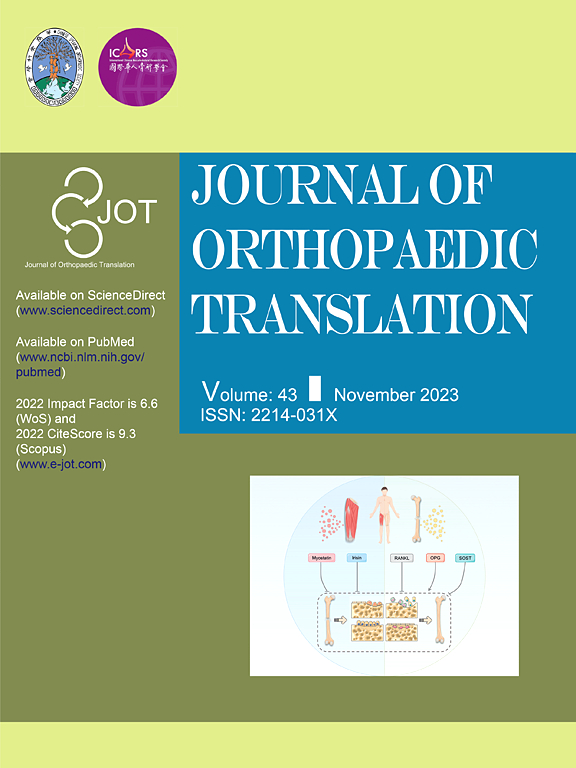骨关节炎患者代谢状态与全因死亡率的关系:一项前瞻性队列研究
IF 5.9
1区 医学
Q1 ORTHOPEDICS
引用次数: 0
摘要
背景:骨关节炎(OA)患者的代谢状态经常发生显著变化,与一般人群相比,其死亡风险更高。然而,没有研究量化OA患者的代谢状态。此外,OA患者的代谢状态与死亡风险之间的关系尚不清楚。方法分析来自英国生物银行(UKBB)研究和1999-2018年国家健康与营养检查调查(NHANES)的OA基线人群。代谢状态采用基于体重指数、腰臀比、血压、空腹血糖、血红蛋白A1c、c反应蛋白、甘油三酯和脂蛋白的综合评分进行评估。限制三次样条用于确定关于死亡风险的每个指标的健康范围。如果因子在健康范围内,则为1,否则为0。总分从0到7分,3分+表示代谢健康状况良好。采用传统的代谢综合征标准(ATP III)和Strict definition进行比较。使用Cox比例风险模型检验代谢不健康与死亡率之间的关系。综合歧视改善(IDI)评估了歧视能力,净重新分类改善(NRI)评估了重新分类在预测十年死亡率方面的表现。结果在44302名UKBB OA参与者中,36.0%的人代谢不健康(得分为0-2),而在5233名NHANES OA参与者中,39.1%的人代谢不健康(基于我们新建立的定义)。调整协变量后,代谢不健康个体的全因死亡风险显著较高(HR: 1.36;95% CI: 1.26-1.47;人力资源:1.16;95% CI: 1.03-1.30在NHANES中)与代谢健康个体相比。在UKBB中,与ATP III定义相比,我们新建立的定义中IDI和NRI的变化分别为0.10%(0.01%,0.20%)和10.60%(1.8%,13.60%)。与严格定义比较,新定义的IDI和NRI变化分别为0.18%(0.10%,0.20%)和12.10%(10.30%,13.80%)。结果。结论提出了一种量化OA代谢不健康的新定义。它确定了代谢状态较差的显著死亡风险,并且在预测准确性方面优于一般定义。结论。骨关节炎是世界范围内主要的关节疾病,承载着沉重的健康负担。我们新建立的定义,通过腰臀比、BMI、血压、血糖、血脂和c反应蛋白来评估代谢健康,在UK Biobank中确定36.0%的OA患者和在NHANES中确定39.1%的OA患者代谢状态不佳,这适用于临床和研究环境。该研究还表明,根据这些标准分类的代谢状态不良与OA患者全因死亡率风险升高显著相关。它进一步强调了维持OA患者整体护理方法的重要性,强调需要同时解决关节和代谢健康问题。本文章由计算机程序翻译,如有差异,请以英文原文为准。

Associations of metabolic status with all-cause mortality among individuals with osteoarthritis: A prospective cohort study
Background
Individuals with osteoarthritis (OA) often experience significant changes in their metabolic status and have a higher risk of mortality compared to the general population. However, no study has quantified the metabolic status of OA patients. Moreover, the association between metabolic status and risk of mortality among OA patients remains unclear.
Methods
The analysis included baseline populations with OA from the UK Biobank (UKBB) study and the National Health and Nutrition Examination Survey (NHANES) 1999–2018. Metabolic status was assessed using composite scores based on body mass index, waist-hip ratio, blood pressure, fasting plasma glucose, hemoglobin A1c, C-reactive protein, triacylglycerols, and lipoproteins. Restricted cubic splines were used to define healthy ranges for each indicator regarding mortality risk. Factors received 1 if within a healthy range, else 0. Total scores ranged from 0 to 7, with 3+ indicating good metabolic health. The traditional metabolic syndrome criteria (ATP III) and the Strict definition were used for comparison. Associations between metabolic unhealth and mortality were examined using Cox proportional hazards models. Integrated Discrimination Improvement (IDI) evaluated discriminatory capacity, and Net Reclassification Improvement (NRI) assessed reclassification performance in predicting ten-year mortality.
Results
Among 44,302 UKBB OA participants, 36.0 % were metabolically unhealthy (scores: 0–2), while in 5233 NHANES OA participants, 39.1 % were metabolically unhealthy based on our newly-established definition. After adjustment for covariates, metabolically unhealthy individuals had significantly higher all-cause mortality risk (HR: 1.36; 95 % CI: 1.26–1.47 in UKBB; HR: 1.16; 95 % CI: 1.03–1.30 in NHANES) compared to metabolically healthy individuals. In UKBB, compared to ATP III definition, the changes in IDI and NRI for our newly-established definition were 0.10 % (0.01 %, 0.20 %) and 10.60 % (1.8 %, 13.60 %), respectively. When the comparison was made with the Strict definition, the newly-established definition showed changes in IDI and NRI of 0.18 % (0.10 %, 0.20 %) and 12.10 % (10.30 %, 13.80 %), respectively. results.
Conclusions
A new definition for quantifying metabolic unhealth in OA was proposed. It identified a significant mortality risk with poorer metabolic status and outperformed general definitions in predictive accuracy. conclusion.
The translational potential of this article
OA is the leading joint disease worldwide, carrying a heavy health burden. Our newly established definition, evaluating metabolic health through waist-to-hip ratio, BMI, blood pressure, glucose, lipids, and C-reactive protein, identified 36.0 % OA patients in UK Biobank and 39.1 % OA patients in NHANES as having poor metabolic status, which is applicable in clinical and research settings. This study also showed that poor metabolic status, as classified by these criteria, is significantly correlated with an elevated risk of all-cause mortality in OA patients. It further highlights the importance of maintaining a holistic approach to care for OA patients, emphasizing the need to address both joint and metabolic health.
求助全文
通过发布文献求助,成功后即可免费获取论文全文。
去求助
来源期刊

Journal of Orthopaedic Translation
Medicine-Orthopedics and Sports Medicine
CiteScore
11.80
自引率
13.60%
发文量
91
审稿时长
29 days
期刊介绍:
The Journal of Orthopaedic Translation (JOT) is the official peer-reviewed, open access journal of the Chinese Speaking Orthopaedic Society (CSOS) and the International Chinese Musculoskeletal Research Society (ICMRS). It is published quarterly, in January, April, July and October, by Elsevier.
 求助内容:
求助内容: 应助结果提醒方式:
应助结果提醒方式:


